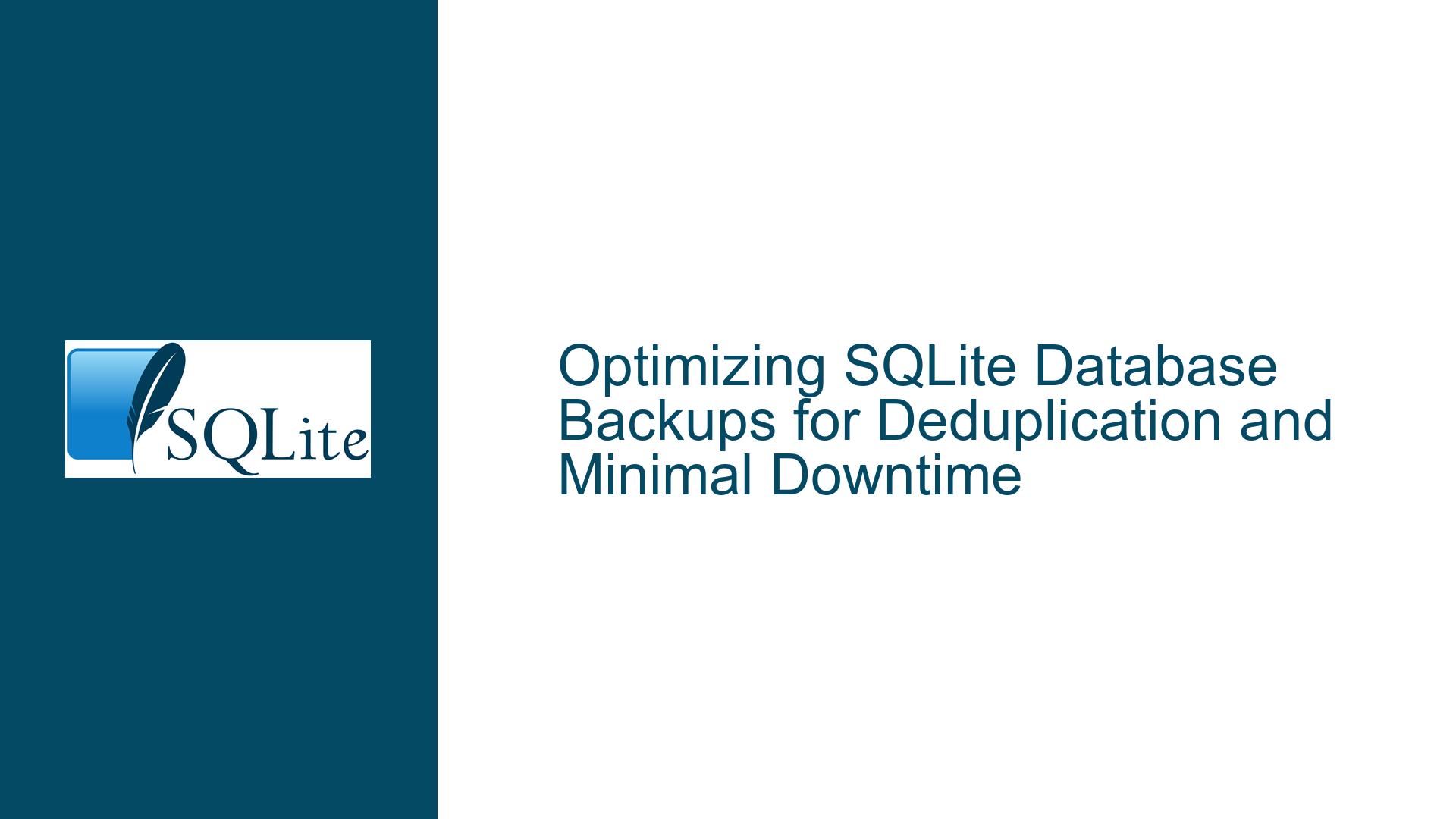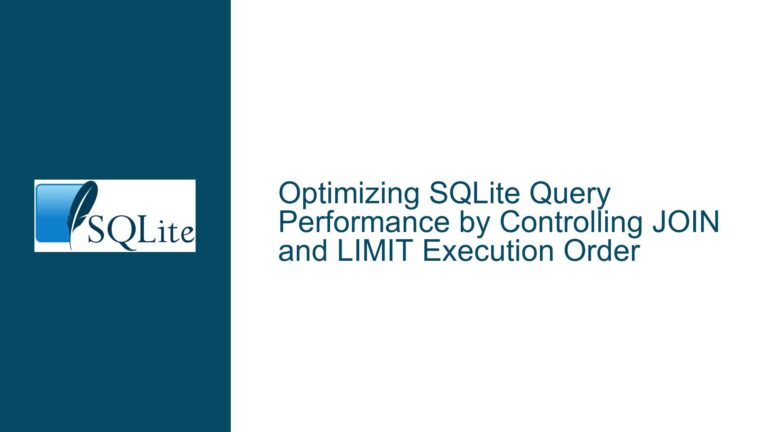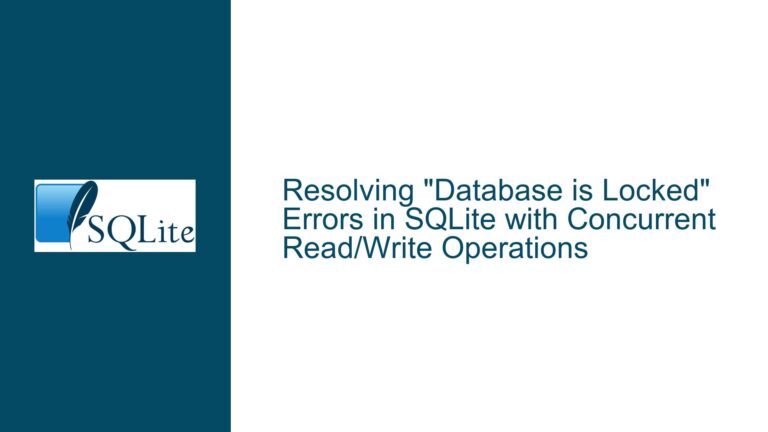Optimizing SQLite Database Backups for Deduplication and Minimal Downtime
Binary Dump Format Challenges in SQLite Backups
The core issue revolves around the need for an efficient backup mechanism for large SQLite databases (e.g., 60GB) that minimizes downtime and maximizes the effectiveness of deduplicating backup tools. The current .dump command in SQLite outputs a textual representation of the database, which includes hex-encoded binary blobs. This encoding doubles the size of binary data, making the backup process slower and less efficient for deduplication. The goal is to find a solution that reduces the backup size, maintains deduplication effectiveness, and minimizes downtime during the backup process.
The .backup command in SQLite creates a copy of the database with acceptable locking periods, but the resulting copies have incidental pointer-level differences due to varying page layouts. These differences reduce the effectiveness of deduplicating backup tools, which rely on matching long runs of identical content. A binary dump format, which avoids the overhead of text formatting and parsing, would be ideal for this use case. However, SQLite does not natively support a binary dump format, leading to the exploration of alternative solutions.
Hex Encoding Overhead and Deduplication Inefficiencies
The primary challenge with the current .dump command is the hex encoding of binary blobs, which doubles the size of the output. This encoding is necessary to represent binary data in a text format, but it significantly increases the size of the backup file. For large databases with substantial binary data, this overhead becomes a bottleneck, both in terms of storage and backup speed. The hex encoding also reduces the effectiveness of deduplication, as even small changes in the database can lead to large differences in the backup file due to the text representation.
Another issue is the inefficiency of deduplication when using compressed backups. Compression algorithms, while reducing the overall size of the backup, tend to obscure similarities between files. This is because compressed versions of similar files can have very different byte sequences, making it difficult for deduplication tools to identify and eliminate redundant data. While some compression algorithms (e.g., gzip --rsyncable or zstd --rsyncable) attempt to mitigate this issue, they still introduce additional overhead and may not fully address the problem.
The discussion also highlights the limitations of using a binary dump format. Since any byte sequence can be present in a binary blob, creating a binary dump format that is both efficient and reliable is challenging. Traditional approaches, such as using MIME boundaries or length-prefixed values, introduce additional complexity and overhead. These methods require careful handling of boundary markers and length fields, which can negate the benefits of a binary format.
Implementing Binary Dump Alternatives and Optimizing Backup Strategies
Given the challenges with hex encoding and deduplication, several alternative approaches have been proposed. One approach is to modify the .dump command to output a binary format that avoids hex encoding. This could involve using a length-prefixed format for binary blobs, where each blob is preceded by its length in bytes. This approach eliminates the need for boundary markers and reduces the overhead associated with hex encoding. However, it requires significant changes to the SQLite codebase and the development of a corresponding import tool to reconstruct the database from the binary dump.
Another approach is to use a combination of .dump and compression, but with optimizations to improve deduplication. For example, using the zstd --rsyncable flag can produce a compressed dump that is more amenable to deduplication. While this approach does not eliminate the overhead of hex encoding, it reduces the overall size of the backup and can be implemented using existing tools. The key advantage is that it does not require changes to the SQLite codebase, making it a more practical solution in the short term.
A more radical approach involves directly copying the leaf pages of the SQLite database’s B-tree structure. This method avoids the overhead of text formatting and hex encoding by preserving the binary format of the data. The idea is to dump the leaf pages in B-tree order, along with any overflow pages, and then reconstruct the database from these pages during restoration. This approach is highly efficient in terms of both storage and backup speed, but it requires a deep understanding of SQLite’s internal data structures and the development of custom tools to handle the backup and restoration process.
Finally, the use of snapshotting file systems, such as ZFS, has been proposed as a way to create instant shallow copies of the database. These snapshots can be used to compute diffs between versions of the database, which can then be backed up instead of the entire database. This approach minimizes the amount of data that needs to be backed up and is particularly effective for incremental backups. However, it requires a file system that supports snapshots and may not be feasible in all environments.
Detailed Comparison of Backup Strategies
| Backup Strategy | Pros | Cons |
|---|---|---|
Textual .dump with Hex Encoding | Simple to implement, human-readable | Doubles the size of binary data, inefficient for deduplication |
| Binary Dump with Length Prefix | Reduces backup size, avoids hex encoding | Requires custom tools, complex to implement |
Compressed .dump with zstd | Reduces backup size, works with existing tools | Compression reduces deduplication effectiveness |
| Leaf Page Copy | Highly efficient, preserves binary format | Requires deep knowledge of SQLite internals, custom tools needed |
| ZFS Snapshots and Diffs | Minimizes backup size, effective for incremental backups | Requires ZFS or similar file system, not universally applicable |
Conclusion
The optimal backup strategy for large SQLite databases depends on the specific requirements of the use case, including the need for deduplication, backup speed, and minimal downtime. While a binary dump format would be ideal, the current limitations of SQLite make it challenging to implement. In the meantime, a combination of .dump and optimized compression (e.g., zstd --rsyncable) offers a practical solution that balances backup size and deduplication effectiveness. For more advanced use cases, exploring custom solutions such as leaf page copying or ZFS snapshots may provide additional benefits, albeit at the cost of increased complexity.






